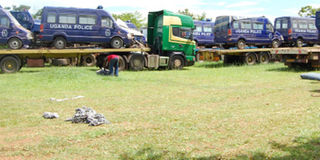Police move to reduce road carnage

The ambulances being off-loaded at Kololo Airstrip. PHOTO BY ANDREW BAGALA
It has often been the trend that when an accident occurs, the first institution to be called is the police. The police, on arrival, bundle the injured victims on the patrol vehicle and drive off to hospital. Some of the patients never reach hospital alive due to the discomfort on the truck.
But these situations are believed to be no more after the police established emergency ambulances on all major roads in the country. Each ambulance has qualified medical personnel to attend to the injured victims.
Police spokesperson, Ms Judith Nabakooba, said although it is the work of the Health Ministry to attend to accident victims, they decided to acquire ambulances and medical teams because their police mission of protecting life and property requires them to lend a hand whenever a life of a person is threatened. The ambulances have been distributed to 10 regions.
“All accident prone areas have been covered like Entebbe Road, Kampala-Masaka, Kampala-Jinja, Kafu-Arua and Gulu highways. These are areas that have the highest accident fatalities,” Ms Nabakooba said.
Accident statistics
The number of people who died in road accidents has increased from 2,734 in 2009 to 2,954 in 2010, which represents an eight per cent rise. A total of 14,148 people (75 per cent) were hospitalised after they suffered serious injuries after they were involved in road accidents while 1,742 people suffered minor injuries.
The Police Commissioner of Traffic and Road Safety, Mr Bazil Mugisha said ambulances were supposed to only to carry victims of accidents to hospitals. “We have given you this ambulance but it should serve the sole purpose. It should not carry charcoal or corpses as it has been reported in some areas,” Mr Mugisha said in Luweero District while handing over an ambulance.
The Executive Director of the Injury Control Centre in Uganda (ICCU), Ms Mable Nakitto, said pre-hospital care given to an accident victim at the scene and the way he or she is transported to hospital are crucial.
“Anything you do at that point determines whether the victim is saved or a minor injury turns severe or cause death,” Ms Nakitto says. Ms Nakitto said, “A person who responds to patients must have knowledge about triage which means there is need to train police officers on these cars.”
Triage is the process prioritizing patients depending on the severity of their condition. Police often respond quickly to victims crying for help yet those who are silent need more attention.
But training of officers is not silver bullet if they personnel aren’t give necessary equipment to use in when such incidents happen, she said.
The ambulances will be equipped with health kits.




